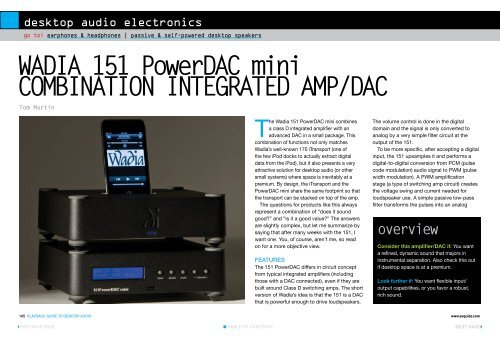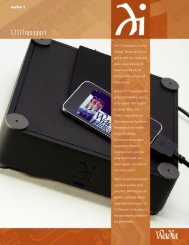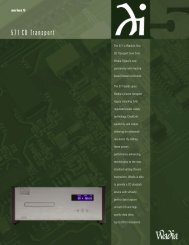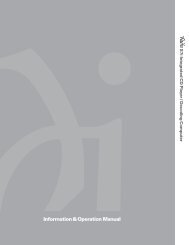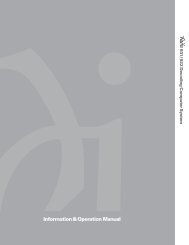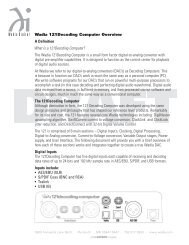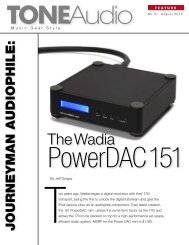wAdIA 151 PowerdAC mini CoMBINAtIoN INtEgrAtEd AMP/dAC
wAdIA 151 PowerdAC mini CoMBINAtIoN INtEgrAtEd AMP/dAC
wAdIA 151 PowerdAC mini CoMBINAtIoN INtEgrAtEd AMP/dAC
You also want an ePaper? Increase the reach of your titles
YUMPU automatically turns print PDFs into web optimized ePapers that Google loves.
desktop audio electronics<br />
go to: earphones & headphones | passive & self-powered desktop speakers<br />
Wadia <strong>151</strong> PowerDAC <strong>mini</strong><br />
Combination Integrated Amp/DAC<br />
Tom Martin<br />
The Wadia <strong>151</strong> PowerDAC <strong>mini</strong> combines<br />
a class D integrated amplifier with an<br />
advanced DAC in a small package. This<br />
combination of functions not only matches<br />
Wadia’s well-known 170 iTransport (one of<br />
the few iPod docks to actually extract digital<br />
data from the iPod), but it also presents a very<br />
attractive solution for desktop audio (or other<br />
small systems) where space is inevitably at a<br />
premium. By design, the iTransport and the<br />
PowerDAC <strong>mini</strong> share the same footprint so that<br />
the transport can be stacked on top of the amp.<br />
The questions for products like this always<br />
represent a combination of “does it sound<br />
good?” and “is it a good value?” The answers<br />
are slightly complex, but let me summarize by<br />
saying that after many weeks with the <strong>151</strong>, I<br />
want one. You, of course, aren’t me, so read<br />
on for a more objective view.<br />
FEATURES<br />
The <strong>151</strong> PowerDAC differs in circuit concept<br />
from typical integrated amplifiers (including<br />
those with a DAC connected), even if they are<br />
built around Class D switching amps. The short<br />
version of Wadia’s idea is that the <strong>151</strong> is a DAC<br />
that is powerful enough to drive loudspeakers.<br />
The volume control is done in the digital<br />
domain and the signal is only converted to<br />
analog by a very simple filter circuit at the<br />
output of the <strong>151</strong>.<br />
To be more specific, after accepting a digital<br />
input, the <strong>151</strong> upsamples it and performs a<br />
digital-to-digital conversion from PCM (pulse<br />
code modulation) audio signal to PWM (pulse<br />
width modulation). A PWM amplification<br />
stage (a type of switching amp circuit) creates<br />
the voltage swing and current needed for<br />
loudspeaker use. A simple passive low-pass<br />
filter transforms the pulses into an analog<br />
overview<br />
Consider this amplifier/DAC if: You want<br />
a refined, dynamic sound that majors in<br />
instrumental separation. Also check this out<br />
if desktop space is at a premium.<br />
Look further if: You want flexible input/<br />
output capabilities, or you favor a robust,<br />
rich sound.<br />
145 Playback Guide to DESKTOP AUDIO www.avguide.com<br />
previous page TABLE OF CONTENTS NEXT page
desktop audio electronics<br />
go to: earphones & headphones | passive & self-powered desktop speakers<br />
power signal.<br />
Wadia claims this approach is less<br />
influenced by potential nonlinearities and<br />
noise. Wadia’s use of digital volume control<br />
is interesting, and is based on some careful<br />
thinking about how to address the standard<br />
problems with this idea (truncation of bits).<br />
Wadia uses a 32-bit digital attenuation system,<br />
which is carefully explained on the Wadia<br />
site (http://www.wadia.com/technology/<br />
technicalpapers).<br />
The <strong>151</strong> also uses Wadia’s WadiaStream<br />
USB 2.0 technology. WadiaStream supports<br />
a maximum throughput rate of 12Mbs and<br />
the preferred isochronous output scheme,<br />
which Wadia says provides bit-accurate<br />
data transmission along with good jitter<br />
suppression.<br />
The Wadia <strong>151</strong> comes in an attractively<br />
simple package. It is a purely digital device,<br />
designed to accept a few digital sources and<br />
connect to one pair of speakers. The rear panel<br />
has one set of five-way speaker connectors,<br />
two coaxial RCA S/PDIF digital inputs, one<br />
USB digital input, one TosLink digital input,<br />
and the standard IEC three-prong connector<br />
for an AC power cord.<br />
To be clear, I should mention that the <strong>151</strong><br />
has no analog inputs or outputs. You can, of<br />
course, use an outboard A/D device, but the<br />
size and expense of this cuts against the grain<br />
of Wadia’s concept here.<br />
As with many modern products, the <strong>151</strong><br />
is really designed to be operated via remote.<br />
The <strong>151</strong>’s remote has the normal controls<br />
for volume, muting and input, as well as<br />
phase and sampling rate (confusingly labeled<br />
“Enter”). The control also covers some items<br />
like track selection that are needed if you are<br />
also using the 170 iTransport. The remote<br />
has no LCD to confirm response to your<br />
commands.<br />
On the front of the <strong>151</strong> box itself, you’ll find<br />
a monochrome LCD window and five buttons<br />
in a row. The buttons let you control input<br />
selection, phase, muting, and volume up and<br />
down. This makes the <strong>151</strong> perfectly usable<br />
without the remote, though I would have<br />
preferred a rotary control for volume.<br />
The <strong>151</strong> box is 8”x 8” x 2” high—the same<br />
size as the 170 iTransport and quite similar<br />
to the old Mac Mini. While this makes for an<br />
attractively small chassis, as mentioned above,<br />
the <strong>151</strong> is not designed to be mounted on its<br />
side, which would further reduce its desktop<br />
footprint.<br />
SONIC CHARACTER<br />
The Wadia <strong>151</strong> has a distinctive approach to<br />
music that I think will work exceedingly well<br />
in some systems but not as well in others.<br />
Because amplifiers do not differ to the degree<br />
that speakers do, let me try to outline the <strong>151</strong>’s<br />
sound in several different ways.<br />
To start, the <strong>151</strong> has a very clear<br />
sound, which I think reveals the smidge of<br />
opaqueness we tend to view as “normal” in<br />
other amplifiers, especially in this price range.<br />
The <strong>151</strong>’s clarity comes through where you<br />
might expect it, in the midrange. Instruments<br />
with strong midrange energy (i.e., most<br />
instruments) seem to have a light shining on<br />
them. That’s partially true because there is<br />
no boomy bass or bright treble to overpower<br />
Ratings<br />
(relative to comparably priced integrated<br />
amps)<br />
treble<br />
midrange<br />
bass<br />
soundstaging<br />
dynamics<br />
value<br />
0 1 2 3 4 5 6 7 8 9 10<br />
the midrange frequencies. In the same way,<br />
the <strong>151</strong> maintains an excellent sense of<br />
instrumental separation, a capability that<br />
usually requires superior handling of microdynamics.<br />
The <strong>151</strong>’s sense of clarity extends up and<br />
down the frequency spectrum. Bass is very<br />
tight and many bass instruments (e.g., kick<br />
drums, string basses) are delivered with a<br />
sense of definition rarely heard except on very<br />
high-end rigs. Treble clarity is also exemplary,<br />
with cymbals in particular rendered with<br />
appropriate definition and decay rather than as<br />
a splash of energy. This suggests to me that<br />
the D/A circuitry is quite good.<br />
I do think that some listeners will find the<br />
<strong>151</strong>’s approach to frequency balance less<br />
than ideal. If you want big, punchy bass or<br />
a warm, relaxed sound you should probably<br />
look elsewhere. Mid-bass seems slightly too<br />
light and controlled on the <strong>151</strong> to be satisfying<br />
specs/pricing<br />
Wadia <strong>151</strong> PowerDAC <strong>mini</strong> Combination<br />
Integrated Amp/DAC<br />
Power: 25Wpc @ 8 ohms, 50Wpc @ 4<br />
ohms<br />
Inputs: Four digital audio (USB, 2xSP/DIFcoax,<br />
Toslink-optical)<br />
DAC Maximum Data Rate: USB—24-<br />
bit/96kHz, other inputs can accept up to a<br />
24-bit/192kHz<br />
Signal-to-noise: 103dB<br />
Outputs: main speaker taps<br />
Dimensions (H x W x D): 2.7” x 8” x 8”<br />
Weight: 6 lbs.<br />
Price: $1195<br />
WADIA DIGITAL<br />
(734) 786-9611<br />
www.wadia.com<br />
with those goals. Even judged against the<br />
absolute sound, I’d say the <strong>151</strong>’s bass lacks<br />
some depth and air (just as many other amps<br />
lack some control when judged this way). And<br />
the midrange glow provided by the <strong>151</strong> tilts it<br />
to the dynamic and involving side of the flavor<br />
spectrum. In this latter sense, it is more like live<br />
music than some of the competition.<br />
While we’re on the subject of dynamics,<br />
it seemed to me that the <strong>151</strong> had adequate<br />
power, but nothing more. Wadia only claims<br />
25 watts per channel, of course. I did have to<br />
146 Playback Guide to DESKTOP AUDIO www.avguide.com<br />
previous page TABLE OF CONTENTS NEXT page
desktop audio electronics<br />
go to: earphones & headphones | passive & self-powered desktop speakers<br />
crank the <strong>151</strong> up pretty far to get satisfying<br />
levels with the admittedly low sensitivity<br />
Usher S520 speakers in our 1900 cubic foot<br />
lab. I also used the PSB Image B4 speaker to<br />
similar effect (note that small speakers tend<br />
to have low sensitivity). Happily enough, the<br />
<strong>151</strong> doesn’t sound strained when you push<br />
it. In a desktop setting or with more efficient<br />
speakers, you’ll probably be fine.<br />
The <strong>151</strong>’s soundstaging is also extremely<br />
good. Low-level detail, as mentioned above,<br />
is handled well rather than trampled into the<br />
dust. As a result you can hear the recording<br />
venue quite clearly. This isn’t a matter of audio<br />
geekery, but rather a characteristic that is<br />
required in order for an amp to deliver a sense<br />
of depth and air and instrumental color.<br />
In a sense, the <strong>151</strong> reminds me of the choice<br />
stereotypically presented by electrostatic<br />
speakers. Bass is well defined, but not deep or<br />
powerful. Midrange is stunningly clear without<br />
being edgy. Treble is smooth and accurate<br />
without being bright or edgy. Ultimate volume<br />
capability is limited, though quite dynamic<br />
within it’s volume envelope. The only thing is,<br />
electrostatic speakers have traditionally been<br />
very expensive—whereas the Wadia <strong>151</strong> really<br />
isn’t, at least within the grand sweep of audio<br />
pricing.<br />
The <strong>151</strong>, like any product, raises questions<br />
of value. If you assume that a good DAC costs<br />
$400-$500, then the $1195 Wadia effectively<br />
sports a $700-$800 integrated amp. That’s not<br />
cheap, but it isn’t exactly a stratospherically<br />
priced single-ended triode product either. My<br />
point here is that some people are willing to<br />
pay a lot for sonic subtleties and the price<br />
premium that the Wadia extracts for such<br />
subtleties is pretty modest.<br />
Another interesting comparison is with the<br />
excellent Peachtree iDecco, which Playback<br />
Editor Chris Martens reviewed a few issues<br />
ago. Compared to the iDecco, the Wadia<br />
seems a bit feature-reduced (and at a higher<br />
price). The Peachtree, for example, has a<br />
headphone amp built in, offers analog inputs,<br />
has a switchable tube stage, can be used as a<br />
standalone preamp or DAC, and even includes<br />
a built-in digital iPod dock (conceptually<br />
similar to Wadia’s iTransport). Of course, the<br />
Peachtree is quite a bit larger (not that it is<br />
large) and to my ears has a more conventional<br />
sound, with less absolute clarity than the<br />
PowerDAC <strong>mini</strong>, but a more balanced mix<br />
of bass/midrange/treble frequencies. You<br />
probably know which kind of buyer you are, so<br />
it really isn’t absolute value that we’re talking<br />
about, but which sonic value set fits your<br />
needs (and listening tastes) best.<br />
MUSICAL EX<strong>AMP</strong>LES<br />
On Cat Power’s “Lived in Bars” from The<br />
Greatest [Matador], the cymbals are clean, with<br />
superb definition as they decay. Some D/A<br />
converters render this as a muddled crash, not<br />
a clear strike followed by waves of vibration<br />
decaying over time. On this same track, the<br />
string bass is very clearly defined, as is the<br />
drum, but through the <strong>151</strong> the latter’s voice<br />
mostly consists of skin sounds, and lacks<br />
some fundamental punch.<br />
You can hear similar things on Jack<br />
Johnson’s “Dreams Be Dreams” from On and<br />
On [UMVD]. The cymbal definition is superb,<br />
and the bass line is tight, but the air that could<br />
be there (this is a bass after all) is reduced<br />
relative to the real thing.<br />
On Eleventh Dream Day’s “Figured It Out”<br />
from El Moodio [WEA], the opening quiet<br />
section has the performers separated so that<br />
you can hear each line distinctly. This sense of<br />
real performers holds up even as the electric<br />
sound is cranked up and the distortion pedal<br />
gets stomped on. The track feels edgy, as it<br />
should, without loosing control or turning into<br />
a fog.<br />
On Hootie and the Blowfish’s “Hannah Jane”<br />
from Cracked Rear View [Atlantic], the vocals<br />
are clear, but some lower midrange vocal<br />
resonance is missing. Darius Rucker is more of<br />
a baritone than the tenor he seems to be here.<br />
Clarity, however, is exemplary.<br />
BOTTOM LINE<br />
The Wadia <strong>151</strong> PowerDAC is one of those<br />
rare reasonably priced products that gives<br />
you more than a glimpse of greatness. It’s<br />
sound is musically involving and fundamentally<br />
solid. Like most such products, it isn’t<br />
without tradeoffs, but if you value midrange<br />
performance and clarity above all else, you’ll<br />
likely love it. Similarly, if you have a room and<br />
system where bass control and heaviness are<br />
problems, this is one amp/DAC you have to<br />
hear.<br />
147 Playback Guide to DESKTOP AUDIO www.avguide.com<br />
previous page TABLE OF CONTENTS Cover page


